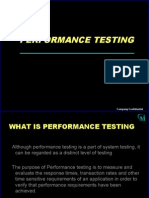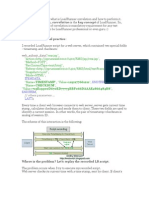Performance Testing Vs Performance Engineering
Uploaded by
kondalbPerformance Testing Vs Performance Engineering
Uploaded by
kondalbPerformance Testing vs.
Performance Engineering
What is performance testing? What is performance engineering? What are the dependencies and differences between performance testing and performance engineering? Are you doing just performance testing or engineering?
Performance testing
Performance Testing is the process of determining the responsiveness of the system under given hardware, software and load conditions. This process can involve qualitative and quantitative analysis. Quantitative analysis like measuring the response time of the business operation in seconds or milliseconds. Qualitative analysis such as scalability, reliability and interoperability. Performance testing can also be done in conjunction with load, stress and volume testing.
The main objectives of performance testing are to identify the bottlenecks on Application under Test. The process of identifying the bottlenecks can be done with diagnosis in different layers of the Application under Test such as presentation layer (web server), business layer (Application Server), data layer (Database). Performance Testing is also used to evaluate the service level agreements (such as average response time of the business scenario, throughput, hits per second and Errors per second etc) of the customer
Performance Engineering
Performance Engineering is an ongoing activity through out the Software Development Life Cycle. It encompasses the set of roles, skills, activities, practices, tools, and deliverables applied at every phase of the SDLC. It will ensure that a solution will be designed, implemented, and operationally supported to meet the performance requirements defined for the application
Objective of Performance Engineering
Increase business revenue by ensuring the system can process transactions within the requisite timeframe.
Eliminate system failure requiring scrapping and writing off the system development effort due to performance objective failure. Eliminate late system deployment due to performance issues. Eliminate avoidable system rework due to performance issues. Eliminate avoidable system tuning efforts. Avoid additional and unnecessary hardware acquisition costs. Reduce increased software maintenance costs due to performance problems in production. Reduce increased software maintenance costs due to software impacted by ad hoc performance fixes. Reduce additional operational overhead for handling system issues due to performance problems
Activities performed as part of Performance Engineering
Identify key development team members as subject matter experts for the selected tools. Specify a profiling tool for the development/component unit test environment. Specify an automated unit (component) performance test tool for the development/component unit test environment; this is used when no GUI yet exists to drive the components under development. Specify an automated tool for driving server-side unit (components) for the development/component unit test environment. Specify an automated multi-user capable script-driven end-to-end tool for the development/component unit test environment; this is used to execute screen-driven use cases. Identify a database test data load tool for the development/component unit test environment; this is required to ensure that the database optimizer chooses correct execution paths and to enable reinitializing and reloading the database as needed. Deploy the performance tools for the development team. Presentations and training must be given to development team members on the selected tools
You might also like
- Compare Performance, Load, Stress TestingNo ratings yetCompare Performance, Load, Stress Testing6 pages
- Performance Testing:: Roles, Activities, and QA InclusionNo ratings yetPerformance Testing:: Roles, Activities, and QA Inclusion56 pages
- Distributed Load Testing in Apache JMeterNo ratings yetDistributed Load Testing in Apache JMeter5 pages
- Application Quality: Sharath Kumar, Technical Manager, Mercury IndiaNo ratings yetApplication Quality: Sharath Kumar, Technical Manager, Mercury India27 pages
- Wipro PoC On Neoload and Oracle Apps enNo ratings yetWipro PoC On Neoload and Oracle Apps en16 pages
- Performance Testing Scalability Report Version1No ratings yetPerformance Testing Scalability Report Version114 pages
- Perfecto Mobile Performance User Guide - V4 August 2014No ratings yetPerfecto Mobile Performance User Guide - V4 August 201424 pages
- Recommendations For Performance Bench MarkingNo ratings yetRecommendations For Performance Bench Marking4 pages
- SOASTACloudTest Performance Testing TutorialNo ratings yetSOASTACloudTest Performance Testing Tutorial52 pages
- Vs-1120 Certified Jmeter Tester - Reading - MaterialNo ratings yetVs-1120 Certified Jmeter Tester - Reading - Material136 pages
- Performance Testing With Jmeter: Gentle Introduction To Writing, Running and Maintaining Test ScriptsNo ratings yetPerformance Testing With Jmeter: Gentle Introduction To Writing, Running and Maintaining Test Scripts17 pages
- Cost Benefits Analysis of Test AutomationNo ratings yetCost Benefits Analysis of Test Automation20 pages
- OpsCenter 7.6 Performance and Tuning GuideNo ratings yetOpsCenter 7.6 Performance and Tuning Guide50 pages
- Methodology To Evaluate Automated Testing ToolsNo ratings yetMethodology To Evaluate Automated Testing Tools8 pages
- Ultimate Web Automation Testing with Cypress: Master End-to-End Web Application Testing Automation to Accelerate Your QA Process with CypressFrom EverandUltimate Web Automation Testing with Cypress: Master End-to-End Web Application Testing Automation to Accelerate Your QA Process with CypressNo ratings yet
- course guide book -Product and Brand managment . 2015 - CopyNo ratings yetcourse guide book -Product and Brand managment . 2015 - Copy5 pages
- (123doc) Bai Tap Mon Tieng Anh Kinh Te Quoc Te Reply and QuotationNo ratings yet(123doc) Bai Tap Mon Tieng Anh Kinh Te Quoc Te Reply and Quotation6 pages
- Lampiran Program Inaeqas / Pkel Perhimpunan Dokter Spesialis Patologi Klinik Dan Kedokteran Laboratorium Indonesia SIKLUS 1-2020No ratings yetLampiran Program Inaeqas / Pkel Perhimpunan Dokter Spesialis Patologi Klinik Dan Kedokteran Laboratorium Indonesia SIKLUS 1-20203 pages
- Lecture 1 - Def-Characteristics-Evolution of EntrepNo ratings yetLecture 1 - Def-Characteristics-Evolution of Entrep59 pages
- Development Project of The Port of NacalaNo ratings yetDevelopment Project of The Port of Nacala18 pages
- Overall Equipment Effectiveness:: Guidelines For The CPG Industry and Its Suppliers100% (1)Overall Equipment Effectiveness:: Guidelines For The CPG Industry and Its Suppliers21 pages
- 301, 3 Floor, Mangal City, Vijay Nagar, Indore Toll Free: 9009010900No ratings yet301, 3 Floor, Mangal City, Vijay Nagar, Indore Toll Free: 900901090010 pages
- Shubhashree Sagar Hotel: Executive SummaryNo ratings yetShubhashree Sagar Hotel: Executive Summary24 pages
- Data Communication & Computer Networks: Week-10 (Lecture 1)No ratings yetData Communication & Computer Networks: Week-10 (Lecture 1)21 pages
- LL.B. I/III/V Semester Annual Exams Rent Control and Slum Clearance LB-5035/LB-5033 (New/Old Course)No ratings yetLL.B. I/III/V Semester Annual Exams Rent Control and Slum Clearance LB-5035/LB-5033 (New/Old Course)2 pages
- Steel and Composite Tied-Arch Bridges: A Conceptual Approach To Structural DesignNo ratings yetSteel and Composite Tied-Arch Bridges: A Conceptual Approach To Structural Design18 pages
- AFI 32-1024 (Standard Facility Requirements)No ratings yetAFI 32-1024 (Standard Facility Requirements)8 pages
- American System of Criminal Justice 16th Edition Cole Test Bank Full Chapter PDF100% (19)American System of Criminal Justice 16th Edition Cole Test Bank Full Chapter PDF28 pages

























































































